|
U.S. Naval Aviation In the South Pacific during WW II Featuring the Lexington Aircraft Carrier The Battle of the Marianas — June 1944 Chapter 1 Page 5 of 7 Pages |
|||||||||||||||||||||
| June 19, continued: After the narrow escapes from torpedo bombers we had had a few nights before, I found this spectacle not only interesting but reassuring. However, before there was time to appreciate it properly, a new line of antiaircraft fire, this time closer and higher in the sky, indicated the presence of another Japanese plane. En route between two cloud patches the Japanese plane began to smoke. When it emerged from the second cloud the smoke stream was thicker. Suddenly a line of fire flashed along the fuselage, went out and then flashed again, brightly now, along the length of the plane, which banked sharply and began to dive toward the water. The pilot tried to dive on the cruiser whose fire had apparently brought him down. Plunging in a vertical blaze, he missed her bow by only a hundred yards or so and the geyser of water that extinguished his plane must almost have splashed her deck.
The destruction of the first two planes was spectacular enough but the end of the third, which followed about a minute later, might have been designed in Hollywood. This time the Japanese, another dive bomber, came in toward us on our starboard beam. Both ships on that side of us began firing simultaneously in two long needles of tracer bullets. For a moment the plane seemed to be held up by a delicate pair of tongs. Then suddenly, without warning of smoke or flame, it exploded in a bright flash and fell in three pieces. |
|||||||||||||||||||||
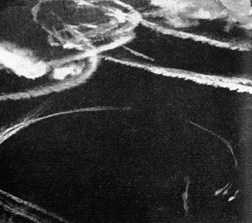 |
Shortly after this event the combat information center gave the ship a summary of reports from farther afield. It appeared now, after the battle had been going on for an hour or less, that two separate groups of about 40 Japanese planes had been completely obliterated by our intercepting fighters, in addition to the three which had penetrated far enough to be put out of action by the ships. We also heard that a group of fighters from another carrier had flushed a covey of 16 Zeros, once the most dreaded Japanese weapon, and splashed 15 of them in less than 10 minutes. For the next hour or two we sat either on the bridge or in the flag plot, listening to more encouraging reports of the same kind. |
||||||||||||||||||||
|
Ctsy: Life Mag., dated 6/17/44 |
|||||||||||||||||||||
| Meanwhile, over the ship’s loudspeaker the executive officer announced in a matter-of-fact tone that the water -distilling system, which had been temporarily out of order, had now been repaired; two swarms of fighters landed and took off again; and about one o’clock a mess boy appeared in flag plot with a large platter of ham, beef and jam sandwiches and a pitcher of first-rate lemonade which he served from a tray on the plotting table. |
|||||||||||||||||||||
| From talk during lunch in the flag plot, I got what turned out to be a well-founded impression of what was going on in the air around us. The Japanese had apparently indeed planned to run a shuttle-bombing service between their carriers and Guam, at our expense. Unfortunately for them, however, they had set out to do this by sending in their planes in groups of 12 to 50 or so; and whereas out of a huge group of 300 a few would have been almost certain to have reached us, these comparatively little clumps were without exception entirely at the mercy of our more numerous interceptors. |
|||||||||||||||||||||
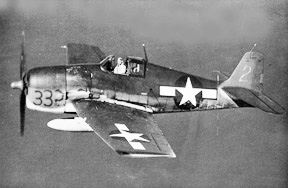 |
|||||||||||||||||||||
|
most widely used carrier fighter Photo ctsy. Life Inc. |
|||||||||||||||||||||
| According to the movies, fighter pilots in ready rooms spend a good part of their time gritting their teeth, giving each other keepsakes to take back to their families and nerving themselves for the supreme sacrifice. In fact nothing of this sort occurs. Between briefings the pilots sit sprawled out playing cribbage or a Navy variation of backgammon called acey-deucey, solving crossword puzzles or languidly discussing business or amatory matters. Far from regarding their profession as sacrificial, they view its hazards in rather the same way that steeplejacks, coal miners or riviters presumably do, as occupational risks surmountable by skill and alertness. |
|||||||||||||||||||||
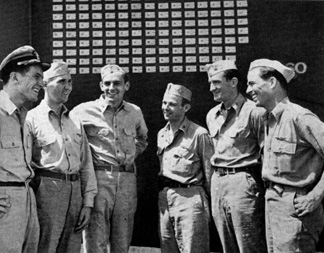 |
|||||||||||||||||||||
|
L to R: Tom Bronn, Clint Swanson, Norm Sterrie, Kent Cushman, Mac McLellan, Buzz Thomas |
|||||||||||||||||||||
| Nor is this admirably functional point of view wholly unjustified, as indicated by the fact that, in the battle of June 19, our carrier’s total loss was one plane, whose pilot was rescued from the water. |
|||||||||||||||||||||
| During the biggest aerial battle in history, our ready rooms were emptier than usual but otherwise no different from other days. Coming back from strikes, the pilots usually stopped to have a drink of pineapple juice or a sandwich at the canteen just outside the door. Then they came in, took a look at the score chalked upon a blackboard and gave a brief version of their activities to one of the intelligence officers who were trying to keep track of what was going on outside. |
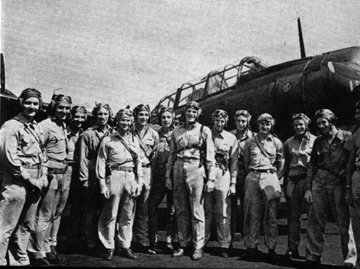 |
||||||||||||||||||||
|
L ro R: Don Kirkpatrick, Cookie Cleland, Orv Cook, Hoggy Glacken, Dupe Dupree, Irish Caffey, Jack Wright, Ralplh Weymouth, Hank Moyers, Pinky Adams, Eugene Conklin, Tom Sedell, Harry Harrison, Don Reichel. Not shown: Jay Shields. |
|||||||||||||||||||||
| The fighter pilots, especially eager to run up their individual and the squadron scores, were in a hurry to get back into the air. Indeed, from their attitude it would have been reasonable to guess that they were engaged not in a battle at all but in some especially fast and exciting game, like polo or hockey. | |||||||||||||||||||||
| Toward 5 o’clock, reports from other ships indicated that the incredible figures of the Japanese disaster had reached a total well above 300 planes and it was clear that the attack had fairly well spent itself. About 5:30, “secure from general quarters” sounded. Men who were not on watch swarmed below to wash and clean up for the late supper. For several previous days, ever since it had been known that the Japanese fleet was on the move, wardroom conversation had been rather scanty and subdued by tension. Now the tension was removed and the hum of talk at the four long, white-clothed tables was noticeably louder. Except for this and the fact that the entree was steak, the supper was much like every other. The pilot who had sat beside me at breakfast was absent, apparently on a flight; another pilot sat down at the other end of the table and someone asked how he had done. |
|||||||||||||||||||||
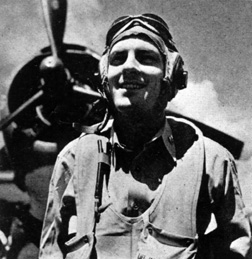 |
|||||||||||||||||||||
|
Ctsy: Mission Beyond Darkness |
|||||||||||||||||||||
| “Not bad — got two,” said the pilot to the officer who had asked him. Then in exactly the same tone he said to the mess boy who asked him how he wanted his steak, “Not too rare.” |
|||||||||||||||||||||
| After supper I went to the bridge in order to listen to the learned postmortems of the day’s activities which were being conducted there. Satisfaction in the magnificent performance by the fighters and the destruction of the Japanese carrier force — estimated to have been about 75% obliterated in the course of the day — was tempered by the fact that circumstances had robbed this victory of some of its rewards. Exposing the landings on Saipan to attack by the Japanese fleet would, of course, have been an unjustifiable risk. Still, had it been taken, the Japanese fleet would now have been to the east instead of to the west of us. |
|||||||||||||||||||||
 |
|||||||||||||||||||||
|
Ctsy: Mission Beyond Darkness |
|||||||||||||||||||||
| With its carriers defenseless and its battleships and cruisers far outnumbered by ours, it would also have been completely at our mercy; and then instead of having won the biggest air battle in history, Mitcher’s task force would have won, in fact, a war.
While the day’s fighting was being thrashed out in conversation not only on the bridge of the carrier but also through the whole ship and perhaps through the whole world, Admiral Mitcher, who was after all chiefly responsible for it, remained perched on his little chair, facing aft of the port side of the flag bridge. At about 9 o’clock, when it was completely dark, he slid off it, stepped deliberately into flag plot, lit a cigarette and sat down on the corner of the leather sofa. With Hedding and Burke he discussed briefly the outline of the next day’s action — night searches by long-range planes based at Saipan and an attack search to be launched at dawn. At 9:30 Mitscher got up from the transom to start down to his sea cabin but at that moment a report of a last bogey came in and he sat down again, still wearing his slightly grim, interested smile, to await the news of its destruction. ?You know,? the admiral said, “tomorrow I’m going to get a haircut. Personally I hate barbers. I hate them like hell. But all the same, tomorrow I’m going to get a haircut.” Chapter 1— End of Page 5 of 7 Pages — Go to Page 6 Page —1 — 2 — 3 — 4 — 5 — 6 — 7 Or This Story’s Cover Page — Editor’s Introduction — Table of Contents Fred Gwynn’s “Torpedo 16” — Chapter — 1 — 2 — 3 — 4 Or Home - Contact Us - Cold War Hist. - 91st SRS Hist. - Stardust 40 Mission Story |
|||||||||||||||||||||